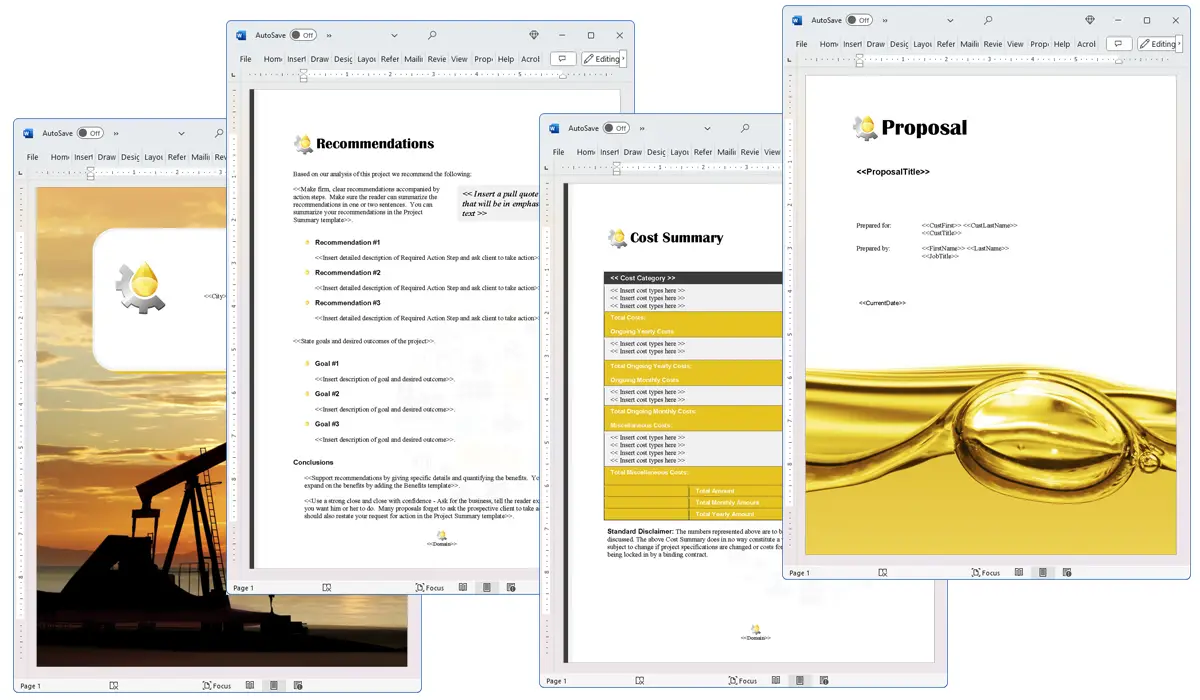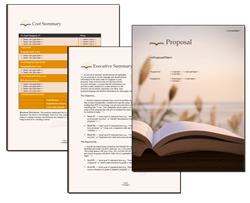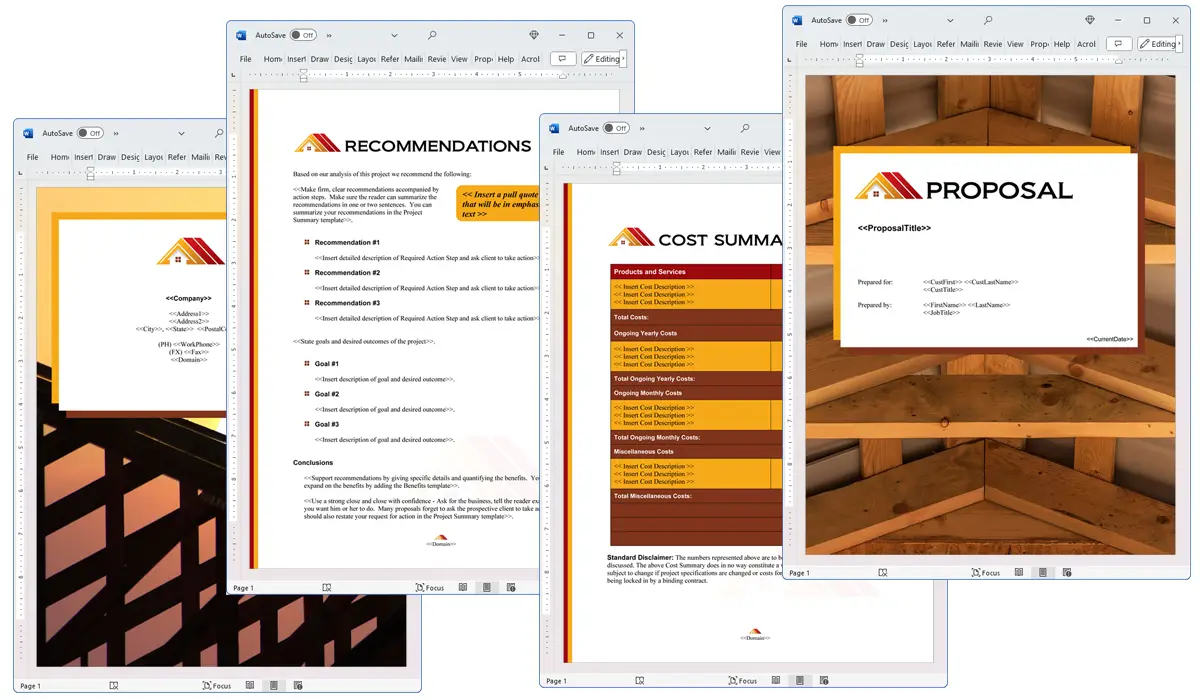What is the Overflow chapter used for?
Proposal Kit Professional Bundle adds more design themes, all six Contract Packs,
a project management library, and Expert Edition software.

Illustration of Proposal Pack Energy #10
We include this Overflow chapter template in every Proposal Pack, along with thousands more. You assemble this chapter with others in various combinations to create custom-tailored business proposals, plans, reports, and other documents. Proposal Packs apply custom visual designs to the templates, giving the final documents a consistent professional finish.
 DOWNLOADABLE, ONE-TIME COST, NO SUBSCRIPTION FEES
DOWNLOADABLE, ONE-TIME COST, NO SUBSCRIPTION FEES
Overview of the Overflow Chapter
In the field of business proposals, clarity and specificity are crucial in addressing every aspect of a project or issue. The Overflow chapter template in the Proposal Kit library serves as a valuable tool for detailing situations involving excess supply or capacity problems within a business context. This chapter template helps businesses articulate the challenges posed by overflow, whether it concerns inventory, scheduling, or resource management, and proposes viable solutions to mitigate these issues.
How is the Overflow Chapter Used?
The Overflow chapter is typically employed in a business proposal when a company needs to address surplus issues that impact operations, storage, and logistics. The chapter allows the proposal writer to clearly describe the nature of the overflow, its causes, and the potential consequences if not addressed. More importantly, it offers a structured way to present a plan for managing or resolving the excess. This could involve selling off surplus goods at a discount, enhancing storage capacities, or adjusting logistical plans to accommodate unexpected changes in supply or demand.
What is Included in the Overflow Chapter?
The content of the Overflow chapter varies depending on the specific needs of the proposal. However, it generally includes:
- Description of the Overflow: Detailed explanation of what the overflow entails and the factors contributing to the situation.
- Impact Analysis: Assessment of how the overflow affects the business, including financial costs, space utilization, and operational disruptions.
- Management Strategies: Various strategies to manage the overflow, which may include temporary storage solutions, redistribution plans, or sale strategies.
- Implementation Plans: Steps and actions proposed to execute the management strategies effectively.
- Future Prevention: Recommendations on how to avoid similar overflow issues in the future, potentially involving adjustments in ordering, inventory management, or capacity planning.
Use Case Examples for the Overflow Chapter
- Supply Chain: Proposing solutions for excess inventory due to cancelled orders.
- Logistics: Addressing unexpected surplus in warehouse capacity needing urgent utilization strategies.
- Transportation: Managing increased vehicle traffic for a large-scale event or construction project.
- Energy: Strategizing on how to handle an overflow of energy production during low demand periods.
- Resources: Discussing the overflow of natural resources in mining operations and its subsequent storage or sale.
- Mining: Tackling the excess output of materials and its impact on storage and transportation.
- Projects: Planning for human resource allocation when there is an overflow due to project scaling.
- General Information: Providing a general overview of overflow issues across various business sectors.
Key Takeaways
- The Overflow chapter is important for detailing surplus-related issues within a business proposal.
- It allows companies to describe, analyze, and propose solutions to manage excess supplies or capacities.
- This chapter is and can be used across various industries including logistics, energy, and mining.
- Effective use of the Overflow chapter can help prevent operational inefficiencies and financial losses.
- Implementing the strategies discussed in the Overflow chapter can enhance overall business resilience and resource management.

Illustration of Proposal Pack Books #3
 What Our Clients Say
What Our Clients SayA simple software tool to meet complex "Request for Proposal" requirements. I’ve used this on a few proposals, and haven’t found an easier solution."
ISC Services LLC
 4.7 stars, based on 842 reviews
4.7 stars, based on 842 reviewsRelated Chapters

The Overflow chapter and other chapters are integrated into a Word document as illustrated here in the Proposal Pack Roofing #2 design theme. There are hundreds of design themes available, and every design theme includes the Overflow chapter template.
A proper business proposal will include multiple chapters. This chapter is just one of many you can build into your proposal. We include the complete fill-in-the-blank template in our Proposal Pack template collections. We also include a library of sample proposals illustrating how companies in different industries, both large and small, have written proposals using our Proposal Packs. This template will show you how to write the Overflow.
We include a chapter library for you to build from based on your needs. All proposals are different and have different needs and goals. Pick the chapters from our collection and organize them as needed for your proposal.
Using the Proposal Pack template library, you can create any business proposal, report, study, plan, or document.
 Ian Lauder has been helping businesses write their proposals and contracts for two decades. Ian is the owner and founder of Proposal Kit, one of the original sources of business proposal and contract software products started in 1997.
Ian Lauder has been helping businesses write their proposals and contracts for two decades. Ian is the owner and founder of Proposal Kit, one of the original sources of business proposal and contract software products started in 1997.By Ian Lauder
 Published by Proposal Kit, Inc.
Published by Proposal Kit, Inc.


 Cart
Cart
 Facebook
Facebook YouTube
YouTube X
X Search Site
Search Site